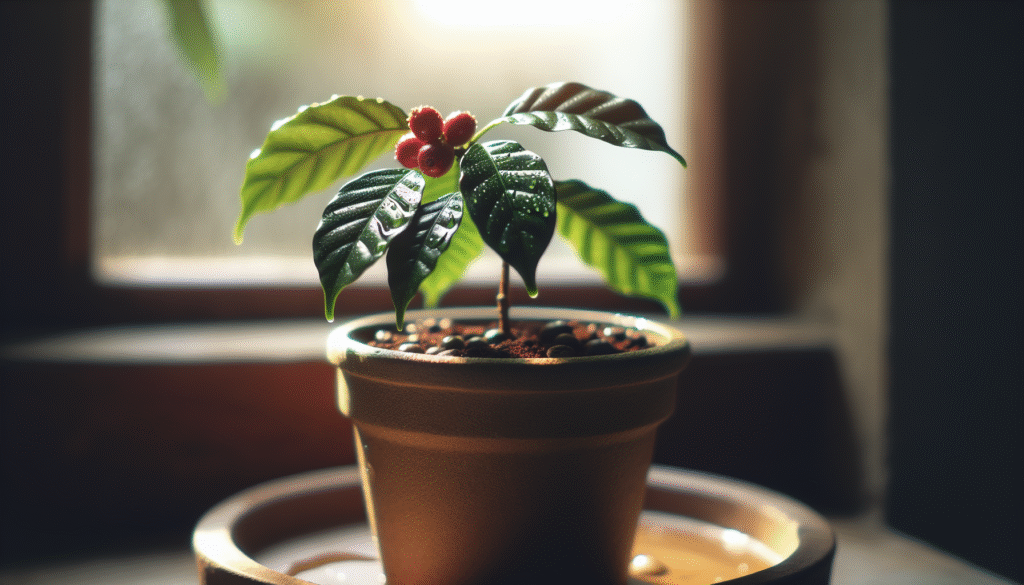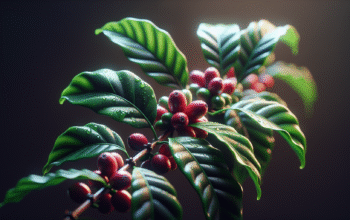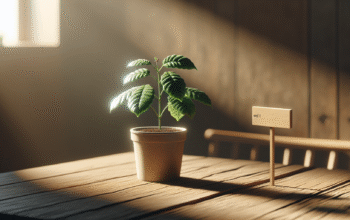? Want to grow a healthy, productive coffee plant that brightens your space and maybe even rewards you with homegrown coffee cherries?
Introduction
Caring for your coffee plant can be a deeply satisfying hobby. Whether you want an attractive houseplant or aim to harvest cherries one day, the right routine and environment will help your coffee tree thrive. This article gives you clear, practical steps and troubleshooting tips so you can confidently care for your coffee plant.
Why grow a coffee plant at home?
Growing a coffee plant gives you a lush, glossy-leaved houseplant with fragrant white flowers and the potential to produce coffee cherries. You’ll enjoy the aesthetic and sensory benefits, and you’ll learn about the plant’s lifecycle and the process behind the drink millions love. You’ll also gain experience with general houseplant care that applies to many tropical species.
Coffee plant basics
Coffea is a genus of evergreen shrubs and small trees, with Coffea arabica and Coffea canephora (robusta) being the most commonly cultivated species. As a houseplant, Coffea arabica is preferred for its size, taste potential, and slightly more forgiving nature.
- Life cycle: The plant grows slowly, flowers in clusters, and produces cherries that mature about six to nine months after flowering.
- Growth habit: Coffee plants prefer a layered canopy, growing as a multi-stemmed shrub if not pruned into a single trunk.
- Typical height: Indoors, coffee plants commonly reach 3–6 feet (1–2 meters) unless pruned or kept in a pot that restricts growth.
Choosing the right variety
Picking the right coffee species is important for your expectations and space. Arabica is ideal for indoor growing and better flavor potential, while robusta is hardier but usually grown commercially.
Coffea arabica
Arabica has smoother, broader leaves and is more sensitive to heat extremes. It prefers consistent conditions and produces cherries with nuanced flavors, making it the usual choice for indoor growers.
Coffea canephora (robusta)
Robusta tolerates higher temperatures and more variable conditions, and it may resist some pests better. Flavor is stronger and more bitter, which is why robusta is common in commercial blends rather than home roasting projects.
Light requirements
Light is one of the most critical factors for healthy growth. Coffee plants are understory bushes in their native habitat, so they grow best in bright, indirect light.
- Ideal: Bright, indirect light for most of the day.
- Acceptable: Morning or late afternoon sun filtered through a curtain.
- Avoid: Harsh midday sun; it can scorch the leaves.
If natural light is limited, you can use grow lights to provide even illumination. Aim for 8–12 hours of light per day when using artificial lighting.
Temperature and humidity
Coffee plants like warm, stable conditions and moderate to high humidity. Mimicking a tropical understory environment will keep your plant comfortable.
Temperature
- Optimal daytime: 65–75°F (18–24°C).
- Nighttime: Not lower than about 55°F (13°C).
- Avoid: Sudden temperature drops and cold drafts, which can cause leaf drop.
Humidity
- Aim for: 50–70% relative humidity.
- Signs of low humidity: Browning leaf edges, yellowing, slow growth.
- Techniques to increase humidity: Grouping plants, pebble trays with water, regular misting, or a humidifier.
Watering: how and when
Watering is often the trickiest part of coffee plant care. You want even moisture without waterlogged roots.
- Frequency: Water when the top 1–2 inches of soil feel slightly dry. This often means once a week, but frequency varies with pot size, temperature, and season.
- Method: Water thoroughly until excess drains from the bottom, then empty the saucer to prevent root rot.
- Signs of overwatering: Yellowing leaves, soft stems, and a musty smell from the soil.
- Signs of underwatering: Wilting, leaf drop, and dry soil pulling away from the pot edges.
Use room temperature water and, if possible, rainwater or filtered water to avoid high mineral content that can build up in the soil.

Soil and potting mix
Your coffee plant will thrive in a well-draining, fertile soil that retains enough moisture yet allows air to reach the roots.
- Composition: A mix of potting soil, peat or coco coir, and perlite or coarse sand works well. You can also add a little compost for nutrients.
- pH preference: Slightly acidic to neutral (pH 6.0–6.5).
- Container choice: Use a pot with drainage holes to prevent bottom pooling.
Sample potting mix recipe
- 40% high-quality potting soil
- 30% peat moss or coco coir
- 20% perlite or pumice
- 10% compost or well-rotted leaf mold
This blend provides structure, aeration, and organic nutrition.
Fertilizing your coffee plant
Fertilizer supports steady growth and better flowering. Coffee plants benefit from regular feeding during the active growing season.
- Frequency: Feed every 4–6 weeks during spring and summer. Cut back in fall and winter as growth slows.
- Type: A balanced, water-soluble fertilizer (like 10-10-10) is fine. You can use a slightly higher nitrogen feed during active growth if leaves look pale.
- Organic options: Fish emulsion, seaweed extract, or compost tea supply nutrients more gently and improve soil biology.
- Application tip: Don’t over-fertilize; salt buildup can damage roots. Flush the pot with water every few months to remove accumulated salts.
Pruning and shaping
Pruning keeps your coffee plant manageable, encourages branching, and can stimulate flowering.
- When to prune: Late winter or early spring before the active growing season begins.
- How to prune: Remove dead or crossing branches first. Then selectively trim to shape the plant and encourage a bushier habit by cutting above a node.
- Hard pruning: If the plant becomes leggy, you can cut it back by one-third to one-half to rejuvenate growth. It may produce strong new shoots afterward.
If you want a single-trunk tree, prune side shoots and tie the main stem gently as it grows.
Repotting
Repotting refreshes soil nutrients and gives roots room to grow. Coffee plants prefer slightly pot-bound conditions, but will need repotting occasionally.
- When to repot: Every 2–3 years or when roots congest the pot and appear at the drainage holes.
- Best time: Spring is ideal, when the plant begins active growth.
- Pot size: Move up one pot size at a time (1–2 inches larger in diameter) to avoid excess soil that retains too much moisture.
- Repotting steps: Remove gently, trim any circling roots, position the plant at the same soil level as before, backfill with fresh mix, and water thoroughly.
Flowering and fruiting
Coffee plants produce small white, jasmine-like flowers followed by green cherries that ripen to red or yellow depending on variety.
- Flowering triggers: Stable conditions and a rest period can stimulate flowering. Many indoor plants flower sporadically rather than in a single flush.
- Pollination: Flowers are often self-fertile but benefit from gentle hand pollination to increase fruit set. Tap flower clusters lightly or use a small paintbrush to transfer pollen.
- Fruit maturity: Cherries generally take 6–9 months to ripen after flowering. Color change to red or yellow indicates readiness.
Harvesting and processing beans at home is possible but labor-intensive. If you plan to try, harvest only fully colored cherries and remove pulp before drying and roasting.
Propagation methods
You can propagate coffee plants by seed or cuttings. Each method has pros and cons regarding speed, viability, and genetic outcomes.
Seeds
- Seed traits: Seeds are best fresh; they lose vigor quickly.
- Process: Sow seeds in a moist, well-draining mix, keep warm (around 70–75°F / 21–24°C), and maintain humidity. Germination can take weeks to months.
- Outcome: Seedlings can show genetic variation, particularly if not from a controlled variety.
Cuttings
- Cutting type: Semi-hardwood cuttings root reliably when taken from healthy, mature plants.
- Process: Take 3–6 inch cuttings with a few leaves, remove lower leaves, dip in rooting hormone, and place in moist propagation mix. Provide bottom heat and high humidity.
- Advantage: Cuttings produce clones of the parent, preserving desirable traits.
Table: Propagation comparison
| Method | Time to establish | Genetic result | Difficulty |
|---|---|---|---|
| Seed | Weeks to months | Variable | Moderate |
| Cuttings | Weeks | Clonal | Moderate–Easy |
Pests and common diseases
Coffee plants can attract pests and face fungal or bacterial issues in humid conditions. Early detection and proper cultural care reduce problems.
Common pests
- Spider mites: Cause stippling and fine webbing; thrive in dry air.
- Scale insects: Look like small bumps on stems and leaves; produce honeydew.
- Mealybugs: Cottony clusters that feed on sap.
- Aphids: Small, soft-bodied insects often found on new growth.
Control measures:
- Inspect regularly and isolate new plants.
- Remove pests manually with a cotton swab dipped in isopropyl alcohol.
- Use insecticidal soap or neem oil sprays for larger infestations.
- Increase humidity to deter spider mites.
Diseases
- Root rot: Caused by overwatering and poor drainage; leads to wilting and yellowing.
- Leaf rust and other fungal spots: Often linked to high humidity and poor air circulation.
- Bacterial blights: Rare but can cause soft, watery spots on leaves or stems.
Prevention and treatment:
- Improve drainage and reduce watering frequency for root problems.
- Prune for air circulation and remove infected leaves.
- Use fungicides as a last resort, following label directions.

Signs of a healthy plant
Knowing what healthy looks like helps you spot problems quickly.
- Vibrant green, glossy leaves with even color.
- New growth at the tips and lateral shoots.
- Firm stems and a stable root system.
- Occasional flowering and, if conditions allow, fruiting.
Troubleshooting common problems
When your plant shows symptoms, try to diagnose the cause by considering water, light, temperature, and pests.
Leaves turning yellow
Possible causes:
- Overwatering leading to root stress.
- Nutrient deficiency, particularly nitrogen or iron. What you can do:
- Check soil moisture and roots.
- Amend fertilizer or apply a balanced feed.
Brown leaf edges or tips
Possible causes:
- Low humidity, inconsistent watering, or salt buildup. What you can do:
- Increase humidity and flush the soil occasionally to remove salts.
Dropping leaves
Possible causes:
- Sudden temperature change, drafts, or underwatering. What you can do:
- Return the plant to stable conditions and check watering habits.
Leggy growth or sparse foliage
Possible causes:
- Insufficient light. What you can do:
- Move the plant to brighter, indirect light or supplement with grow lights.
Seasonal care and adjustments
Your care routine should change with the seasons. Adjust light, water, and feeding to match the plant’s growth cycle.
- Spring and summer: Active growth—more water, regular feeding, possible repotting.
- Fall: Gradually reduce fertilizer and water as growth slows.
- Winter: Keep temperatures stable, reduce watering frequency, and provide adequate humidity.
Harvesting and processing cherries (if you aim to produce beans)
If your coffee plant fruits, you can try processing cherries into green beans for roasting. It’s a lengthy but rewarding process.
- Harvest: Pick cherries when fully colored and slightly soft.
- Pulping: Remove the outer skin and pulp to reveal the beans (usually two seeds per cherry).
- Fermenting (optional): Some methods use a short fermentation to remove mucilage, followed by rinsing.
- Drying: Lay beans in a single layer to dry in a shaded, airy spot until they reach about 12% moisture.
- Hulling: Remove the dried parchment to get green beans ready for roasting.
Home roasting requires specialized equipment or careful stovetop/oven methods. Start with small batches and monitor temperatures closely.
Styling tips for indoor display
Coffee plants can be attractive additions to living rooms, offices, or sunrooms. Positioning and styling can boost both aesthetics and plant health.
- Use decorative pots with drainage holes and a matching saucer.
- Place near east- or west-facing windows with a sheer curtain to filter intense sun.
- Group with other humidity-loving plants to create a microclimate.
- Prune into a neat shape or allow a natural, bushy silhouette depending on your preference.
Safety and pets
Coffee plants contain caffeine and other compounds that can be toxic to pets if ingested in large amounts. Keep plants out of reach of pets and children, or choose a display location where access is limited.
Long-term care and expectations
With steady care, your coffee plant can live for many years. Expect modest flowering and cherrying when conditions are right, but don’t be discouraged if fruiting is sporadic indoors. Over time, you’ll get a feel for the plant’s rhythms and what adjustments produce the best results in your space.
Quick reference care table
This table summarizes the main care points for a handy reference.
| Element | Recommendation |
|---|---|
| Light | Bright, indirect light; avoid harsh midday sun |
| Temperature | 65–75°F (18–24°C) day; above 55°F (13°C) night |
| Humidity | 50–70% relative humidity |
| Watering | Water when top 1–2 inches dry; avoid waterlogging |
| Soil | Well-draining mix, slightly acidic (pH 6.0–6.5) |
| Fertilizer | Every 4–6 weeks in growing season; balanced feed |
| Repotting | Every 2–3 years, springtime |
| Pruning | Late winter or early spring; shape and remove dead wood |
| Propagation | Seeds or semi-hardwood cuttings |
| Pests | Watch for spider mites, scale, mealybugs, aphids |
Frequently asked questions
This section answers common queries about coffee plant care to help you act confidently.
How long until my plant flowers or fruits?
Indoor coffee plants may take 3–5 years to reach maturity and flower, depending on species and growing conditions. Some plants may flower earlier if given ideal light, nutrition, and a stable environment.
Can I grow coffee from grocery store beans?
Grocery-store roasted coffee beans won’t germinate. You need fresh, unroasted seeds (green coffee seeds) or live plants. Seeds must be fresh to remain viable.
How do I encourage flowering?
Provide consistent light, moderate fertilization, slightly cooler nights in late winter to mimic a seasonal cue, and reduce watering slightly before the expected flowering window. Stable conditions are most important.
Is my coffee plant edible?
The cherries contain seeds that become coffee beans after processing and roasting. Raw cherries have a sour, pulpy taste; the seeds are bitter raw and need processing and roasting to become drinkable coffee.
Final tips for success
- Be patient and observe your plant closely—small adjustments often bring big improvements.
- Keep a care journal to track watering, feeding, and environmental changes.
- Treat issues early: catching pests or nutrient problems early prevents major setbacks.
- Enjoy the process: growing a coffee plant connects you to the plant-to-cup story in a meaningful way.
Conclusion
Caring for your coffee plant is a rewarding commitment that blends horticulture, patience, and attention to detail. By providing appropriate light, steady humidity, balanced watering, and occasional feeding, you’ll foster a healthy plant that brings beauty and potentially even coffee cherries into your home. With practice, you’ll refine your routine and gain the satisfaction of nurturing a plant that represents one of the world’s most beloved crops.



